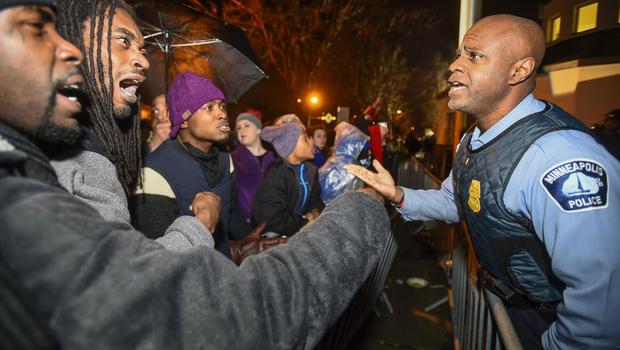Filed under: Critique, Editorials, Midwest, Police, White Supremacy

AWWP shares strategic reflections from organizers in the police abolition movement across the country. This piece comes to us from a black anarchist comrade in Minnesota, who has been active in the protests against the police murders of Jamar Clark and Philando Castile since last year.
The movement around Black Lives Matter in Minneapolis is changing shape and picking up pace. In recent years Minnesotans have seen movements around anti-war, welfare reform, the rights of Indigenous peoples, students, Muslims, LGBT people–and of course the anti-police brutality and Black Lives Matter protests starting in 2015. With the officer-involved shootings of Jamar Clark and Philando Castile among a host of others, people are taking to the streets and organizing.
The Twin Cities has a unique and contradictory activist landscape, with many institutions that are both socially “progressive” and institutionally racist. A running joke / slogan among leftists calls the Twin Cities the “The Land of 10,000 Non-profits” (a play on the state motto “the land of 10,000 lakes”). A massive number of philanthropic, charitable, and non-profit organizations advocate for social change in the U.S, and many work hand-in-hand with State and Federal bureaucracies. In Minnesota in recent years, activists began naming this phenomenon the “non-profit industrial complex.” Now we are seeing how this plays out in grassroots movements.
In the wake of the Bernie Sanders campaign and the Jamar Clark protests, many activists are growing frustrated with the slow moving politics of large non-profits and politicians. While some feel helpless, others are forming new coalitions and tendencies with more autonomous politics. Throughout the winter of 2015-16, people worked tirelessly confronting District Attorney Mike Freeman, only to win a No Grand Jury decision in Jamar Clark’s case; others fought for the rights of black, queer, and Muslim youth. My comrades and I spent winter developing an African caucus of the IWW* with largely anarchist/libertarian communist/socialist politics. Others in our circle organized alongside prisoners, confronted racism in schools, supported families of victims of police brutality, studied anti-fascism, cop watched, and threw educational events. Work work work work work.
When the streets filled with bodies fighting for justice for Philando Castile on July 6th, it came as no surprise that the participants were militant. In place of the North Minneapolis residents who had occupied the 4th Precinct after Jamar Clark’s murder, this time we saw militant youth from Rondo neighborhood in St. Paul take space on the highway to protest. Anarchists came out as well, and their presence drew accusations and badjacketing the following day from large nonprofit organizations, BlackLivesMatter MPLS, and other self-appointed activist leaders. These groups presented the same tired narrative that was perpetuated by Police Chief Harteau after the 4th Precinct occupation, the same tired narrative used during Civil Rights and other movements. Former Black Panther Mumia Abu-Jamaldescribes this narrative at work during the Civil Rights era, when white and black students from the North were cast as “outside agitators” by white southern segregationists, and Governor George Wallace redbaited the Southern Christian Leadership Conference as “professional agitators with pro-communist affiliations”.
Today the narrative continues: while right-wing journalists and bloggers label Black Lives Matter a Marxist or Islamist organization, liberal movement leaders similarly draw upon the “white anarchist” scapegoat to denounce militancy in the streets. It’s very frustrating. The overall assumption of liberals and moderates is that they can spot an anarchist just by looking at them (hint: you can’t). In the process, “anarchists” of color and anyone passing out resources, standing with the people, lending a hand and thinking up clever tactical strategies are erased from the narrative. But real will always recognize real. As we speak, new coalitions are being built and the number of radical militant organizers is growing.
As crowds marched to the highway on July 9th, they chanted the familiar line “No justice, no peace! Prosecute the police!” But soon other ideas entered the mix: People pushed folks’ thinking and stretched their imaginations by instead chanting “ABOLISH THE POLICE!” Folks have since had serious conversations about the role of police in class society.
Police and prison abolition can sound scary in the absence of creative thinking and study. That’s why I appreciate anarchism, because it offers a framework to have conversations and create something new, something humane, something without capitalist corruption and hierarchy. The O in anarchism’s “circle-a” symbol represents Order. An order that is created by community and without coercion. An egalitarian order. In Minnesota, radicals are beginning to understand that the police and prisons are violently coercive. Let’s learn, talk, grow, and organize revolutionary solutions together.
–A black anarchist in Minneapolis
Notes
*The Industrial Workers of the World is a revolutionary anti-capitalist union formed in 1905, which organizes in workplaces, communities and prisons in the U.S. and around the world.





